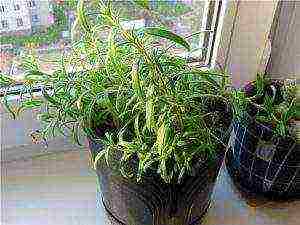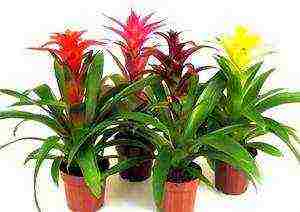Content
- 1 Features of growing citrus fruits
- 2 Lemon Tree
- 3 Indoor tangerines
- 4 Orange
- 5 Calamondin
- 6 Grapefruit
- 7 Citron
- 8 Video "Growing citrus at home"
- 9 Difficulties in growing homemade citrus plants
- 10 Species suitable for growing at home
- 11 Cuttings
- 12 Tips
- 13 Planting material - seeds
- 14 How to grow a tangerine
- 15 Tangerine care
- 16 Watering and replanting
- 17 How to grow an orange tree
- 18 Bloom
- 19 Indoor lemons
- 20 For lovers of exotic
- 21 Which citrus fruits are suitable for growing in pots
- 22 Conditions for indoor citrus cultivation
- 23 Where to get planting material for growing citrus fruits
- 24 Caring for citrus fruits indoors
- 25 The best varieties for home cultivation
- 26 What to choose - planting seeds or cuttings
- 27 How to grow lemon on your own?
- 28 How to "make" citrus fruit
- 29 Helpful hints
- 30 Conclusion
Citrus indoor plants are not only a wonderful decoration of the home, but also useful plants, the fruits of which are rich in vitamins and excellent taste. Growing these southern treats in the home, however, requires special conditions that differ for each type of fruit. In this article, we will look at how to grow citrus fruits in a pot in a city apartment.
Features of growing citrus fruits
Growing citrus fruits at home involves adhering to the basic rules of caring for southern crops.
First of all, indoor citrus fruits need a properly selected soil. For the base, you can take the soil "flower" or "lemon", diluting it one part at a time with foliage, sand and humus and three parts of turf. In structure, such a soil will be low-acid, lumpy and loose, which will provide free access of oxygen and moisture to the plant's root system.
It is better to plant the plant in clay pots, which, due to their properties, are excellent conductors of heat. In addition, these pots "breathe", which will allow excess moisture to evaporate without lingering in the soil.
Citrus fruits in pots need to maintain an optimal moisture level - at least 65%. The fruits grown in humid air will turn out to be juicy and tasty, however, with an excess of humidity, they are threatened with decay and abscission. Citrus houses need to be watered as the soil dries up: in winter this happens once a month, in summer - once every 1-2 weeks. On hot days and during the heating season, the plant needs regular spraying.
In an apartment, most often citrus fruits stand on the windowsill, since it is there that the plant will be provided with sufficient access to light and heat. If there is not enough lighting (for example, on the north or north-west side of the apartment), then it is necessary to provide citrus with additional lighting using ordinary lamps with good heat transfer. The temperature during the entire period of development should not fall below +8 degrees. In winter, the temperature regime should be maintained in the region of + 12-15 degrees, and with the onset of spring - not lower than +18. Thanks to warm temperatures and high-quality lighting, the plant will begin to release buds, the flowering of which will mark the proximity of fruiting.
Reproduction of citrus fruits is carried out at the end of summer by separating the growing shoot from the main cutting.Such a shoot is carefully trimmed and cleaned from the bark below, after which it is lowered into a pre-prepared pot with nutrient soil, which is fertilized with moss, manure and a small amount of peat. The pot must have holes in the bottom, which are necessary for the outflow of excess water.
You can propagate by seeds and grafting, but for this it is better to familiarize yourself with the varietal characteristics of the plant, since even fertile trees during reproduction can become inedible.
Pruning citrus fruits is essential not only to keep the plant healthy, but also to create a beautiful round shape that can be created after the second year of the plant's life. If the aesthetic side requires pruning too long shoots, then the vegetative one - too thick. Shoots that grow inside the crown and hinder the free development of buds due to their large numbers should also be removed. Pruning is done in the spring, all cuts are made at an angle.
If you are interested in how to grow a citrus tree on your own, then there are two options - cuttings or from a stone at home. The apartment is ideal for this, since it is possible to create conditions in it that are as close as possible to those of a greenhouse. Growing from cuttings is recognized as the best method, since this method will provide you with fruits in the coming years, while plants obtained from seeds begin to bear fruit at least 10 years later.
Consider the varieties of citrus trees for an apartment in more detail.
Lemon Tree
The lemon tree is an unpretentious and persistent citrus fruit that shows good fruiting and hardiness results. In addition, lemon gets along well in low light and moisture conditions. Keep in mind, however, that the lemon tree needs regular pruning and fertilization, as a well-groomed tree will provide you with delicious and aromatic fruits.
Lemon is planted from seeds or cuttings. As already mentioned, plants from seeds will begin to bear fruit only after 10-15 years. For development, planting material of varieties Pavlovsky, Maikop, Novogruzinsky is used - these are varieties specially created for home conditions.
Lemon care is simple: regular watering, bait, crown pruning. The only thing that can be difficult is the need to replant the lemon tree in a larger pot annually.
Indoor tangerines
Mandarin, like lemon, requires regular transplanting in the spring. In addition, it is more thermophilic and picky about the level of humidity. It is better not to keep home tangerine at temperatures below +20 degrees, otherwise the plant will quickly die. However, a clear advantage of the species is its faster period of entry into fruiting - within 5–6 years, the development of fruits is possible.
Mandarin, in addition to the requirements for lighting and moisture, also needs regular feeding and treatment from pests. Unfortunately, these plants are very susceptible to aphids, spider mites and mealybugs. Also, the problem of mandarin is the complexity of the flowering process, which often needs stimulation.
Orange
The orange tree in the apartment is not only a supplier of sweet fruits throughout the year, but also a source of wonderful aroma. However, the problem with the orange is its poor tolerance to low temperatures, which will require constant temperature maintenance at 18-24 degrees. In addition, an orange requires direct sunlight for at least 2 hours a day, but no more than 3 hours, which is difficult when choosing a growing location, since, with all this, the tree does not like anxiety and rearrangements.
This type of citrus fruit needs regular watering and spraying, which should be carried out at least 2 times a week.The best varieties of homemade oranges are Gamlin, Pear-shaped Korolek, Washington Navel and Adjarian.
Calamondin
Calamondin is a citrus plant with a mandarin-like fruit appearance. However, unlike the latter, calamondin is less whimsical to light and moisture, moreover, it is very frost-resistant for a tropical plant. The tree reaches a height of 90 cm, and bears fruit all year round.
Calamondin is best grown from cuttings or store-bought annuals. Such a tree will begin to bear fruit as early as 2-3 years.
Despite the resistance to cold weather, the optimal growing temperature in summer is 21-25 degrees with a humidity of 70%, and in winter - 10-16 degrees with a humidity of 50%. This regime will provide the plant with healthy and abundant fruiting.
Grapefruit
Homemade grapefruit can be obtained from Duncan and Marsh varieties. This variety of citrus fruits resembles a lemon in terms of keeping conditions. However, the grapefruit needs more abundant and frequent watering and the maximum amount of sunlight.
Citron
Citron is a plant with very large yellow fruits (from 15 cm in length) and thick skin. For home cultivation, the varieties Pavlovsky, Buddha's Hand and Mir are suitable. It should be remembered that the size of the fruit requires a tall tree (1.5 m), which should provide an abundance of sunlight and warm temperatures throughout the year.
Video "Growing citrus at home"
From this video you will learn how to grow and care for lemon, tangerine, lime at home.
Growing citrus indoor plants at home is an interesting activity, but far from simple. Therefore, those who believe that it will be enough to plant a bone in the ground, and that's all - lemons for tea are no longer necessary to buy. Without special knowledge, the first harvest of citrus indoor plants, if they do, will not earlier than in twenty years.
But if you know some of the nuances and grow correctly, observing all the rules, then you can enjoy the fruits much faster. But even here it is important not to make a mistake in choosing a variety. For growing on a windowsill, only those citrus indoor plants that have been grafted on seedlings of orange, lemon, grapefruit or kumquat are suitable. Those crops that were grown from cuttings cut from fruit-bearing trees have also proven themselves quite well.
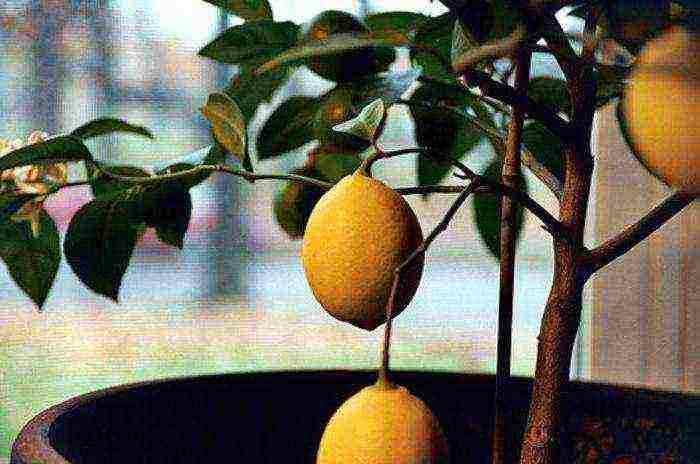
Difficulties in growing homemade citrus plants
It would seem that it is simpler: you need to go to a flower shop and buy a pot in which a flowering or already bearing citrus grows - a "golden orange", a Meyer's lemon, which is not very difficult to take care of at home, or a tangerine. You just need to bring the tree home, place it on the windowsill in the right place, and start watering. But this is not at all the case, since it is really difficult to grow a lemon or tangerine at home, moreover, this process is somewhat different from caring for ordinary specimens.
Those plants that are sold today in flower shops most often come to the shelves from abroad, mainly from Holland. There they are kept in ideal conditions from the first day: the optimum temperature for growth, high humidity are maintained, supplementary lighting is supplied, and fertilizers for citrus indoor plants are constantly applied to the soil. When buying on dwarf trees, by the time they are sold, there may be a dozen or more fruits.
But after getting on the windowsills, beautiful citrus indoor plants immediately begin to face stressful conditions. In our houses, the illumination is much lower - several times, and the air (especially in winter) is incredibly dry compared to the greenhouse, and growth stimulants stop helping after a while.
Therefore, in conditions of a shortage of their internal resources, citrus indoor plants begin to throw all their strength into preserving the fruits with which they were so abundantly strewn in the store. And as a result, the overwhelming majority of purchased "pets" die.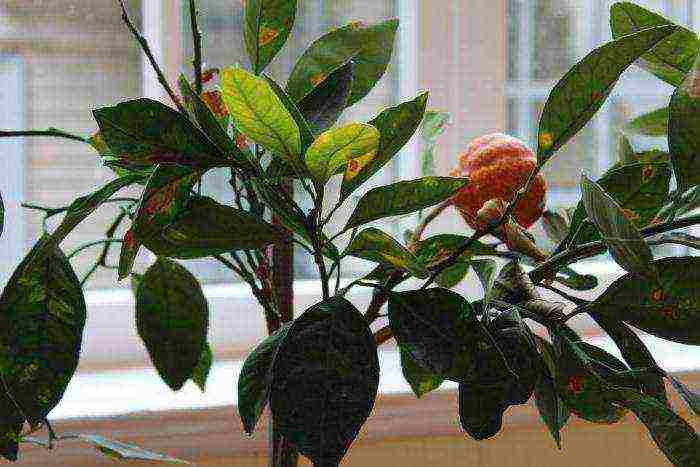
Species suitable for growing at home
Citrus crops have long been known to man. Their people have been actively cultivating for so long that it has become difficult to detect their wild-growing ancestors in nature. Most often outdoors, citrus fruits are cultivated in countries with tropical or subtropical climates. And it is from there that their fruits are delivered to store shelves in all corners of the planet.
A novice grower who cannot pay too much attention and time to a pet growing on his windowsill should choose varieties of indoor citrus plants that are easier to care for. If we talk about subspecies for a small apartment, then it is preferable for beginners to grow lemon, tangerine and trifoliate, since their growth is easier to restrain. In turn, oranges, grapefruits or pomelo, which are large in size, turn into a rather bulky tree in a couple of decades.
As for exotic varieties, today a close relative of mandarin is quite common - citrus kumquat nagami, as well as calamondin. Speaking of amazing varieties, the Hand of Buddha must also be mentioned.
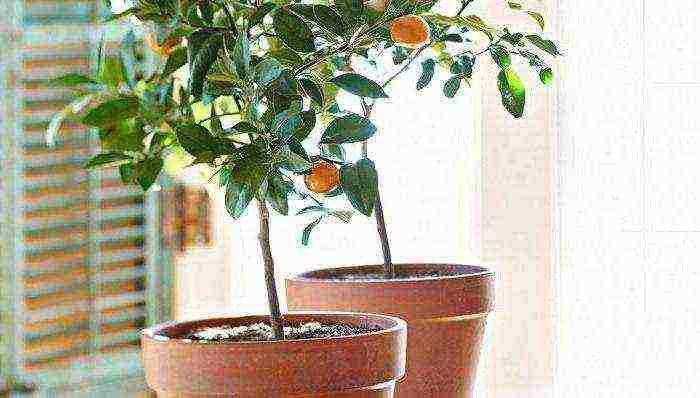
Cuttings
The most convenient option for those who decide to grow a citrus crop on their own will, of course, be a young plant, which was purchased in a specialized store. But a purchased tree does not always take root in the house for many reasons. However, if, after all, the culture has migrated from the store to the apartment, you need to contact the seller and get a recommendation from him for adapting the citrus to the new conditions.
First, the plant needs to be inspected. If there are fruits on it, then they will have to be cut off. For seven to ten days, citrus should be left in a store pot, and only then transplanted into a new one.
Tips
Citrus trees grown from material obtained by cuttings take root best at home. Of course, it will be difficult for beginners who have a poor idea of how to grow tangerine, lemon, etc.
The cuttings should be cut from a well-developed and healthy citrus tree. The length of the planting material should be between ten and twelve centimeters. It should have at least three buds. It is not recommended to use either too young or old enough shoots with dense wood.
The best time for harvesting cuttings is April. Rooting of the planting material can be carried out in a glass of water or in a soil consisting of earth and sand. In the latter case, the cutting should be covered, for example, with a plastic bottle. The roots will appear in about twenty days. After that, the rooted stalk can already be planted in a permanent pot.
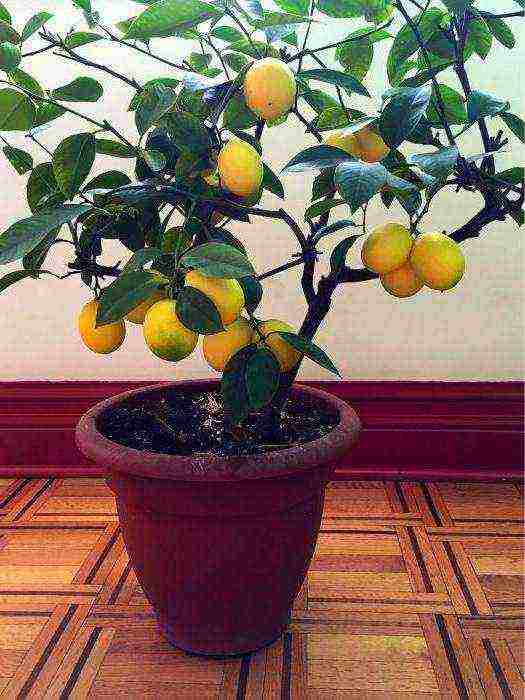
Planting material - seeds
You can often hear that a seed planted in the ground turns into a luxurious citrus tree over time. But, even despite the fact that growing tangerine or lemon from seeds is the most affordable way for amateurs to propagate this type of plant, the result is often unpredictable.
As a result, you can get a culture, the fruits of which will be much smaller than the parental form, or you can grow a new excellent pet. Judging by the reviews, the use of seeds pulled from fruits as planting material often leads to a lack of flowering in such seedlings.
The seedling begins to germinate in about a month and a half, and it should be transplanted at the stage of the appearance of five leaves.
How to grow a tangerine
After the juicy fruits of this citrus bought in the store are eaten, you can use the remaining seeds as planting material. For the greatest probability of success of the event, it is better to have more seeds, since definitely not all will germinate. Therefore, to obtain seedlings, you need to take a dozen seeds.

The planting material is placed in cheesecloth for several days and slightly moistened. This is necessary so that the bones, swelling, "hatch".
Tangerines can be grown at home in special citrus soil purchased from a flower shop. Although, in principle, almost any light soil is suitable for this culture. For example, in mixed in equal proportions turf and leafy soil, to which compost and rotted manure humus will be added, the tangerine will be very comfortable. Do not make peat-based soil. We must not forget about the need for drainage. Quite a long time should pass before the first shoots appear. The sprouts become noticeable only after two to three weeks, and sometimes even after a month.
Mandarin is a tree that grows rather slowly at home, and it sometimes stops its growth. Therefore, you should not lose hope and enthusiasm, because when this citrus is provided with all the necessary conditions, it grows into a very beautiful tree.
Tangerine care
According to agronomists, tangerine is a very unpretentious tree to maintain, not only among citrus fruits, but also among many other plants, but it still requires observance of certain rules when leaving. The most important condition for him is the abundance of sunlight. Mandarin requires intense lighting up to twelve hours a day all year round.
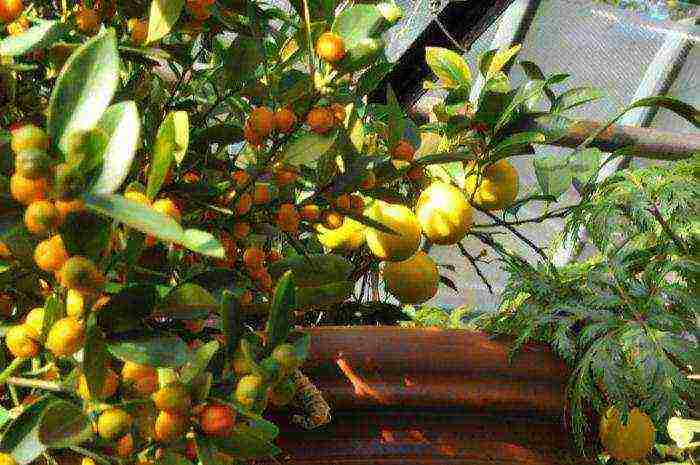
Watering and replanting
Mandarin is no less anxious about humidity. In the summer months, it should be watered abundantly without flooding, while in the winter the water supply should be reduced, periodically making sure that the soil does not dry out. In addition, it is necessary to spray the leaves daily, using filtered or boiled clean water for this purpose. You can compensate for the dryness of the air by placing a small decorative indoor fountain next to the tangerine. As it grows, the tree needs to be transplanted into larger pots periodically. It is best to carry out the movement in early spring. In this case, the new pot should have a diameter of three to five centimeters larger than the previous one.
Transplanting a tangerine tree is done by the transshipment method, while it is necessary to preserve the old earthen lump as much as possible so as not to accidentally harm the root system of the plant. For the first time, plants that have bloomed need to adjust the number of ovaries. In the first year, two or three fruits are left, in the second, seven or eight, and then about ten.
How to grow an orange tree
Home care for this type of citrus crop is not very different from the growing conditions for tangerine. Both a newly acquired tree and one that has been growing in the house for many years must be transplanted every year. The best time for this is spring, when the plant is just getting ready to expend energy for growth. For young crops, regular watering and spraying is a prerequisite for a normal existence.
Bloom
An orange tree, which is not very difficult to take care of at home, will give ovaries if the crown is correctly formed. This plant blooms and bears fruit on twigs at least five orders of magnitude, so you should not expect fruit to appear earlier than five years later. The crown is formed quite simply. When the branches reach a length of ten to fifteen centimeters, they are pinched. Soon, new shoots begin to awaken from the lateral buds, which should also be shortened. As a result, only after five years you can get an orange tree with many short shoots.
In this case, the room should be cool: 17-20 degrees. At higher temperatures, the fruits are not set, and the plant itself is sick or affected by pests.
Indoor lemons
Of all the varieties, Pavlovsky is considered the most unpretentious. This type of lemon feels good even on northeastern or northwestern windowsills, it is comfortable in relatively dry air and with rare dressings.
The Panderosa variety is almost as unpretentious, but it needs more light. True, this type of lemon has a special "syndrome" that is found only in him: it produces too many flowers to the detriment of the growth of green mass. Therefore, extra buds must be constantly cut off.
Slightly less common is Meyer's lemon, caring for which at home involves following certain rules: if they are not followed, it grows very slowly. However, flower growers, even with little experience, can simply place the pot on a light windowsill, feed the plant from time to time, and spray it if necessary.
For lovers of exotic
Citrus fruits in our understanding are lemon, orange, tangerine. But there are representatives of this plant species that many of us have not even heard of. Of the tangerines, the Unshiu variety is interesting, which, in comparison with other representatives of the species, is relatively tolerant of poor lighting and unpretentious, just like Pavlovsky lemon.
Other close relatives of citrus fruits are Kumquat and Calamondin. Lovers of original indoor plants should definitely get these types of plants.
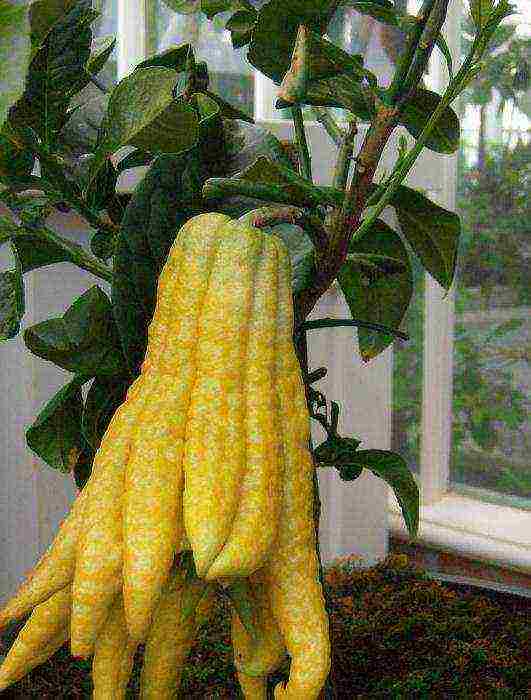
Speaking of exotics, one should definitely mention the Buddha Hand variety. This citrus is distinguished by the unusual appearance of its fruit: it resembles a lemon in color, and outwardly - a fleshy brush on the hand. However, there is no edible pulp inside. Nevertheless, the fruit is so exotic that it should definitely be grown at home.
Download Original] ’class =" imagefield imagefield-lightbox2 imagefield-lightbox2-resizeimgpost-500-500 imagefield-field_imgblogpost imagecache imagecache-field_imgblogpost imagecache-resizeimgpost-500-500 imagecache-field_imgblogpost-resizeimgpost-500-500 ″>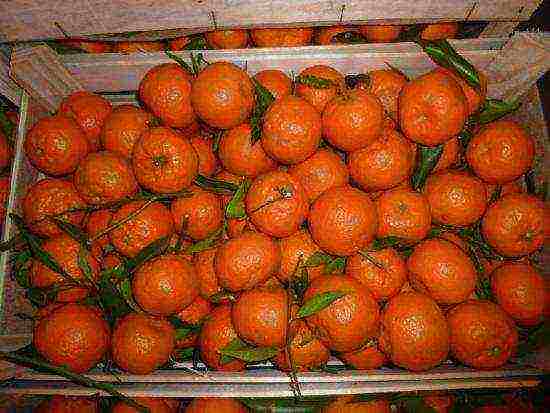
Various citrus crops have long been known to man. They have been actively cultivated by it for so long that it is not always possible to find their wild-growing ancestors in nature. In the open field, citrus fruits are most often cultivated in countries with tropical and subtropical climates, from where the fruits are delivered to all corners of the world. On the shelves of stores in any country are:
- oranges
- lemons
- tangerines
- grapefruit
The bright fruits make it attractive to grow citrus fruits at home. Getting started with this exciting activity, you need to choose a species and variety suitable for cultivation in the room.
Content:
- Which citrus fruits are suitable for growing in pots
- Conditions for indoor citrus cultivation
- Where to get planting material for growing citrus fruits
- Caring for citrus fruits indoors
Which citrus fruits are suitable for growing in pots
Not only in Asian countries, but also in countries with cold climates, the tradition of growing indoor citrus fruits goes back several hundred years. The cultivation of lemons is especially popular.
Indoor lemons
If you plant a lemon seed in the ground, it will surely sprout. Sooner or later, the sprout will turn into a fairly large tree, but most likely there will be no fruits on it. For growing in pots, lemons of special, indoor varieties are most suitable:
- Pavlovsky is a popular self-pollinated indoor variety with trees from 1.0 to 2.0 m high, fragrant flowers, large fruits
- Novogruzinsky - trees up to 1.5 m high, flowers are large, flowering begins at the age of four years, gives fruits weighing up to 120 grams
- Maikop - a variety obtained as a result of folk selection, bears fruit abundantly, lives for a long time
- Genoa - trees are not tall, without sharp outgrowths, in the fifth year it gives up to 50 fruits
The choice of varieties of indoor lemons is very large, which confirms the popularity of these plants among fans of indoor floriculture. The assortment of other citrus fruits is somewhat more modest, but still there is a huge selection here.
Tangerines
Among all citrus fruits, tangerines most easily tolerate low temperatures; tangerines of the following varieties are suitable for growing indoors:
- forged - Vasya - in indoor conditions, trees are not higher than 1 m, blooms and bears fruit from the second year
- Sochi 23 - fruits are bright, orange, slightly flattened, weighing up to 80 grams
- clementine - a hybrid of orange with tangerine
Oranges
Orange varieties for growing in pots:
- gamplin - dwarf plants no higher than 1.5 m, one of the best and most productive indoor oranges
- pear-shaped beetle - a popular orange with pear-shaped fruits
- Pavlovsky - the best indoor variety
- Adjarian seedless - fruits are bright, flat-round
In addition to the above citrus fruits, you can grow kumquat and its hybrids at home:
- calomondin - hybrid with tangerine
- orangish - with orange
- limequat - with lime
Bitter oranges, grapefruits, and various hybrids also grow at home. Despite the fact that this list is far from complete, all citrus indoor crops need certain conditions.
Conditions for indoor citrus cultivation
As with all potted citrus plants grown in the room, the important conditions are:
- lighting
- temperature
- humidity
- the soil
Lighting and temperature
Like all plants from tropical and subtropical climates, citrus fruits are demanding on lighting. For their cultivation, it is best to choose windows facing south, southwest, southeast. In the event that this is not possible, a pot with a citrus plant can be placed near any window with additional lighting.
For this, one fluorescent lamp is sufficient. In addition, there are shade-tolerant crops among these crops. Like lighting, temperature is very important for citrus crops. Moreover, the summer regime is different from the winter one.
Starting in spring, pots of citrus fruits should be placed in a room where the temperature does not drop below + 18. This will promote bud formation and the beginning of flowering. In winter, most citrus fruits need to be grown at + 12 degrees. Tangerines can be kept at this time of the year and at + 8. If the seasonality is not observed in the temperature regime, then you can not wait for the formation of buds and full flowering.
Humidity and watering
The optimum moisture content for most citrus fruits should be at least 60%. On hot summer days as well as in winter. with hot radiators, citrus fruits should be sprayed with warm water at least once a day. These plants respond well to a warm shower.
Water the plants as the soil dries up in 1/3 pots. In winter, watering is quite rare, you can water citrus fruits once every 3-4 weeks, but without waiting for the soil in the pot to dry out completely. Since all citrus fruits are long-livers, for their cultivation it has a soil composition in a pot.
The soil
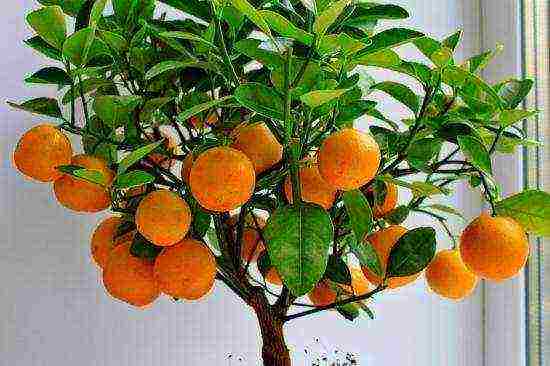
Citrus potting mix can be purchased to fill the pot for citrus potted crops. If this is not possible, then you can prepare the soil yourself. For younger plants, the following composition is suitable:
- coarse sand or finest gravel - 1 part
- well-rotted manure - 1 part
- land, leaf, - 1 part
- land, turf, - 2 parts
If the soil is needed for transplanting and growing an adult, from 5 years old, a plant, then such a soil composition is suitable in which there will be three parts of sod land, and all other components one by one.
Where to get planting material for growing citrus fruits
Most often, planting material can be:
- buy
- get by cuttings
- grow from seed
How to choose a citrus plant in a store
The most convenient planting material for home growing citrus crops will be a young plant purchased from a special store. Important! You only need to purchase a plant from a trusted seller or manufacturer.
Most often, when making a purchase of a plant in a serious store, you can also get recommendations on how to adapt it to new growing conditions.Try not to get a very mature plant with a lot of already formed fruits. When buying, you need to inspect the leaves from the bottom side, it is these places that various pests love.
Video about growing citrus fruits in the room:
Also, the plant should not have serious mechanical damage. A small amount of ovary or adult fruit is acceptable. The optimal ratio is one fruit per 15 leaves. After the acquisition, the fruits will have to be cut off. For a week, the plant should be kept in the purchased pot, and then transplanted into a new one.
Rooting cuttings
The shoot must be cut from a well-developed, healthy citrus tree to obtain a cutting. The length of the cutting is about 10 - 12 cm; at least 2-3 buds must be present on it. Do not take shoots that are too young or too old with dense wood.
The best time to harvest cuttings is April. Rooting can be carried out both in a glass of water and in soil consisting of earth and sand, covering the stalk with a part of a plastic bottle. The roots appear in about 20 to 25 days. The plant can then be planted in a permanent pot.
Growing from seeds
Despite the fact that growing from seeds is the most accessible for amateur breeding of citrus fruits, the result is unpredictable. You can get a plant whose fruits will be inferior to the parent form, or you can get a new superior plant. However, it is also possible that a seedling obtained from seeds does not have flowers. Seeds sprout in about a month, and the seedling needs to be transplanted at the 5-leaf stage.
Caring for citrus fruits indoors
Top dressing
It is necessary to start feeding the plants in the spring. This is especially important for mature, fruiting plants. The first two or three dressings with a difference of 14 days should be organic, and all subsequent ones should be mineral. For organic fertilizing, you can use ready-made biohumus. For mineral dressings, a complex mixture for indoor flowers is suitable.
Transfer
As you master the pot, the plant needs to be transplanted into a large container. The best time to transplant is late winter or early spring. Young plants are simply transferred to a new pot. Important! Do not transplant a plant with flowers and fruits.

It is difficult to transplant large, adult plants from large tubs, but in order to renew the soil, you need to remove about 1/4 of the soil from above and replace it with a new one.
Hygienic care
All citrus fruits do not tolerate the presence of dust on the leaves. Dust can be removed with a clean, damp cloth. In the summer, about once every 5 days, citrus fruits can be used for a warm shower. In addition to all of the above, in summer, citrus pots can be taken out into the garden or on the balcony.
Growing citrus fruits indoors is not only exciting, but also useful, since all citrus fruits clean the air in a room well, making it healthier for humans.
Exotic flora has long been popular with indoor florists. Now no one can be surprised by tropical plants that get along well on window sills with geraniums and violets. Citrus fruits in the indoor flower garden are not the last. Many people manage to grow a beautiful tree, but not everyone can boast of homemade lemons. What is the reason? How to grow a lemon to bear fruit?
The best varieties for home cultivation
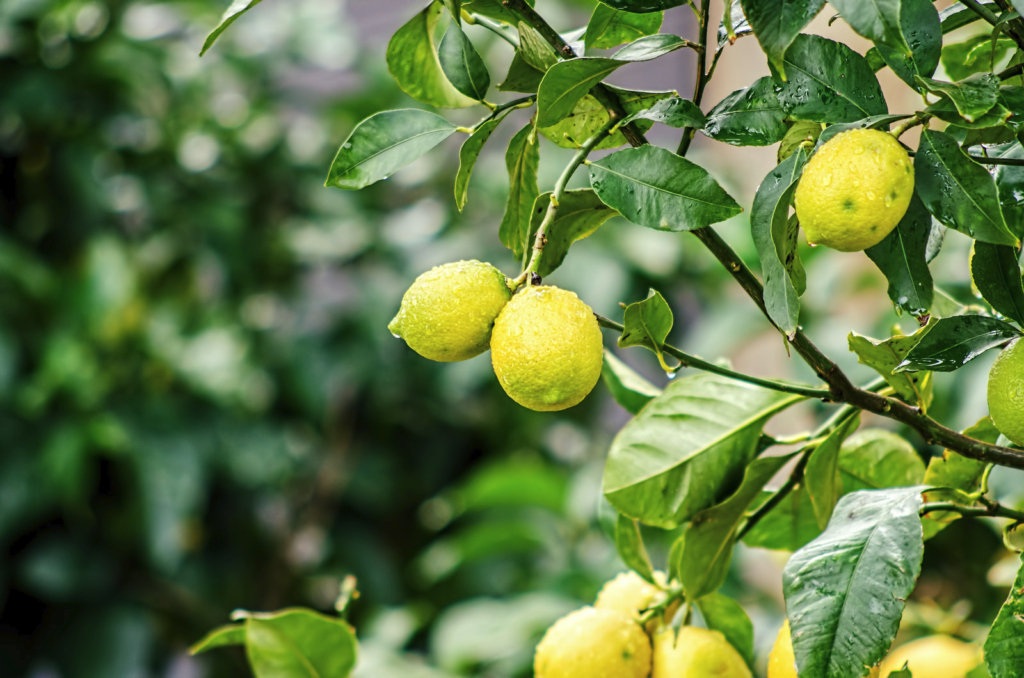
Under natural conditions, a lemon is a fairly tall tree with a spreading crown, its height reaches 8 meters.
Of course, it would take up a lot of space in the apartment, so dwarf varieties were bred specifically for home floriculture. They are neat bushes that give a very good harvest.
If you decide to grow lemon at home, then pay attention to the following varieties.
- Meyer, or Chinese dwarf. The most popular and low maintenance variety.Withstands lack of light well. The shortest of all known varieties. Meyer is a lemon-orange hybrid, so lemons have a sweet taste. Fruits can be set after 18 months of growth, flowering is abundant.
- Pavlovsky. Bred in the Nizhny Novgorod region. It reaches a height of 1.5 meters, propagates by cuttings and yields a harvest in the third year. From one plant, you can get from 10 to 30 fine-peeled pitted fruits. It blooms twice a year. The tree lives up to 45 years.
- Novogruzinsky, or Novo-Afonsky. A fairly tall tree, up to 2 m. With large leaves and flowers of a lilac hue. Fruiting in 4-5 years, lemons weighing up to 120 grams, fragrant and tasty.
- Maikopsky. Medium dwarf, lush, with a lot of thin twigs, yields many tasty fruits.
- Ponderosa, or Canadian. A hybrid of lemon with grapefruit. Flowering begins in the second year after rooting. The yield is small, from 3 to 7 pieces, but the fruits are large in size, their weight can reach 1 kg. Unpretentious, does not need additional lighting.
- Eureka. A frost-resistant variety, it can be grown outdoors in mild climates, withstands temperatures down to -5 degrees. Fruits appear in the second year of growth, large, thick-skinned and tasty. The plant reaches a height of 1-1.5 meters.
- Genoa. A low-growing bush without thorns. It blooms and bears fruit throughout the year, resistant to adverse conditions. Differs in high productivity.
Whichever variety you choose, with proper care, each tree will delight you with its decorative appearance, lush flowering and yellow or orange lemons.
What to choose - planting seeds or cuttings
Unlike oranges and tangerines, lemon is easy to graft and grows quickly from an ordinary seed. How to grow lemon at home - by cuttings or from seeds, which method is better? Let's take a look at the features and disadvantages of each method.
Seeds
- You may not wait for the first harvest at all; under favorable conditions, it will bear fruit no earlier than 6-7 years from the moment of planting.
- Difficulties with the formation of the crown. The tree should be constantly cut, watch out for excess branches.
- In contrast to grafted plants, lemons grown from seeds produce a higher yield.
Cuttings
- Propagation by cuttings allows you to grow a stronger and more viable plant.
- If the cutting is taken from a fruitful tree, then the probability of getting fruits without additional vaccinations is very high.
- Many varieties propagate only by cuttings, since their fruits are seedless.
- The flowering and ovary of lemons begins much earlier than those grown from seeds. But cuttings should be taken from a mature plant that has borne fruit at least 2 times.
How to grow lemon on your own?
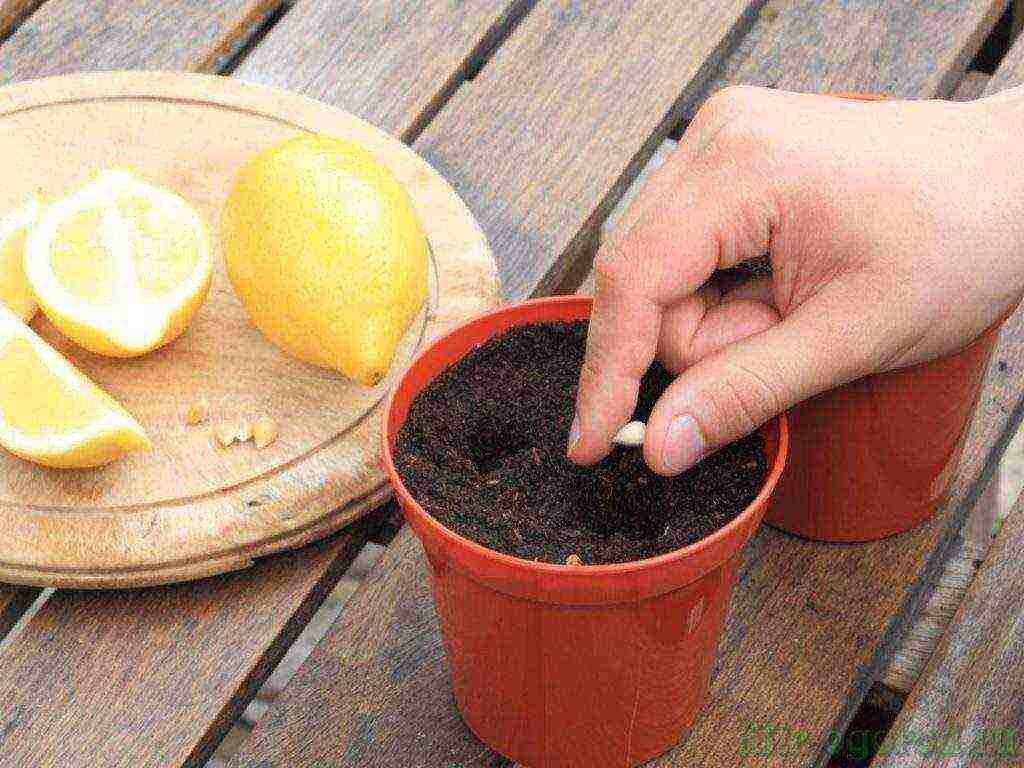
Have you chosen a way to plant a lemon? Well, let's get to work.
Soil requirements
Since lemon will grow in a confined space, you need to choose the right soil for planting and make sure it is loaded with nutrients.
If you are planning to dig up land in a garden or vegetable garden, then this is a bad idea. The garden soil is too dense, does not have the necessary drainage, and indeed has an incomprehensible composition and is most likely inhabited by small pests in the form of bugs and worms. But if you insist and understand the soil, then take 3 parts of sod land and one part of sand and humus. Take sod land under old deciduous trees, except for oak and poplar, cut off a layer no deeper than 10 cm.
But it is best to purchase a special citrus blend from flower shops. In an extreme case, a universal substrate will do, but its acidity should be between 5.5 and 6.5 units.
Every 3-4 years, the tree needs a transplant, so discard the old soil without regret, and fill up the new, fresh one.
Lemon roots are small, so there is no need to buy a large pot.For a young plant, it is enough that the height of the container is 20 cm, and the diameter of the upper part is no more than 15 cm.
Pot
There is a wide variety of pots and pots in stores. What's the best for citrus? Let's figure it out.
- Clay. Clay containers are characterized by good porosity and are saturated with water. On the one hand, the tree will not suffer from a lack of moisture, and on the other, it can rot from its excess. Rapid evaporation through the walls of the vessel cools a clod of earth, and lemons are tropical plants, it is harmful for them. Salts and minerals are deposited on the inner walls, the roots are drawn to nutrients and often grow into the clay. During transplantation, the root system is severely damaged. Well, the fragility of the material is of no small importance. The slightest blow, and you have to look for a new place of residence.
- Plastic. Ceramics, of course, are more beautiful than plastic. But plastic is cheap, lightweight and durable. Among the disadvantages, a homogeneous structure can be noted, which does not allow excess moisture to evaporate through the walls. But the risk of rotting can be reduced by using a drainage mat on the bottom. Ease of construction - the tree will be less stable than in a heavy clay pot.
- Wood. It combines all the advantages of clay and plastic, but fragility and deformation from water is a significant drawback. Usually, a "mature" plant is transplanted into wooden tubs, which has survived childhood sores and a period of growth. In this case, the inner surface is impregnated with special components and lined with a film to avoid rotting.
With the material sorted out, now pay attention to the dimensions. As a guideline, the diameter of the top is approximately equal to the height of the pot. But the bottom should be narrowed. And the more branchy the crown, the wider the pot.
Drainage holes are required! Up to 2.5 cm in diameter, and for a large container, it is better to add a couple more.
With each new transplant (every 3-5 years), the pot should grow two to three centimeters. When the lemon stops growing, it can be left alone, but it is necessary to periodically remove the top layer of the "depleted" earth and add a new nutrient substrate.
You cannot plant a young plant immediately in a large tub, the earth will quickly oxidize, and the lemon will hurt.
Disembarkation process
Now let's figure out how to plant a lemon so that it is comfortable and it quickly grows. Consider two ways: a stalk from an elite variety and an ordinary bone taken from a fruit bought in a store.
Seeds or seeds
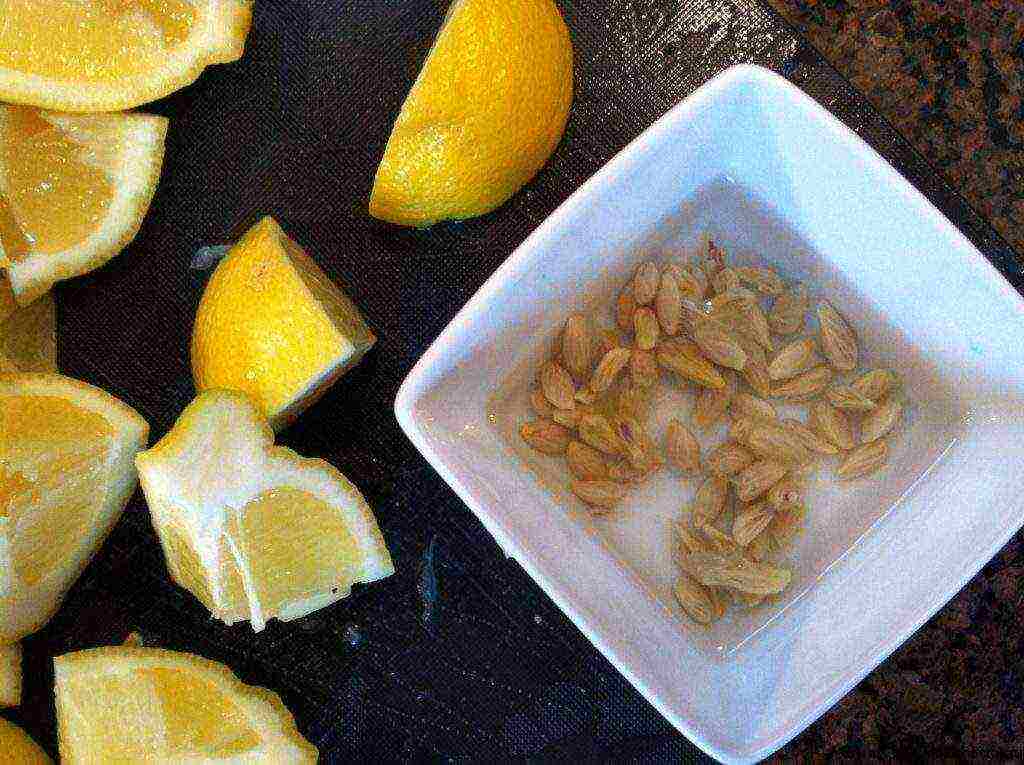
There is no need to buy seeds from the store, just take a juicy ripe fruit and select a few intact seeds.
Now the fun begins - germination. There are two ways. The first one - poke fresh, freshly extracted bones into the ground to a depth of 1-2 centimeters, put them in a bright place without drafts and periodically moisten the ground. Hatching time is up to two weeks.
But since a person is a curious creature, and a woman is doubly, then you will periodically poke around in the pot in search of nascent life, which means that you can inadvertently damage the tender sprouts. Therefore, we pass to the second method.
Place the seeds between two layers of cotton wool soaked in water. You can sometimes satisfy your curiosity by lifting the top layer. As soon as the sprout appears, carefully transfer it to the ground.
Cuttings
You got a stalk from friends who have a fruiting lemon. Your actions are as follows.
- First, you need to know if you got the right cutting. It should reach 10-15 centimeters in length, up to 5 millimeters thick, have a keratinized layer and 3-4 leaves. A fresh cut is best dipped in ash to prevent decay. And if you also treat it with an additional growth stimulant, then rooting will take place quickly and without problems.
- Secondly, for successful cuttings it is necessary to create a favorable microclimate of 20-25 degrees and good lighting.
- Third, stick the prepared shoots into the citrus soil and spray liberally with a spray bottle.
Cuttings will root very quickly if you provide them with warmth, light and moisture.
Sprout care
Cover sprouts from seeds or unrooted cuttings with plastic transparent cups or glass jars to create a microclimate. Spray the young growth every day and harden with fresh air, temporarily removing the cans.
A seed sprout can be released from the kindergarten of the greenhouse when 4 leaves appear. Successful rooting of cuttings is determined by the appearance of new leaves.
Fertilizer and transplant
Young trees practically do not need feeding; more mature plants that have reached 3-4 years of age should be additionally fertilized. In the spring-summer period, the procedure is carried out once every 3 weeks, and in the cold season - once a month.
You can use folk remedies or buy fertilizers at the store. Use the purchased funds according to the instructions.
Young shoots are transplanted several times throughout the year, then the transplant depends on the growth of the plant. During the period of active growth - once a year, then every 3-5 years.
The most favorable time is the beginning of spring, when new leaves did not appear and inflorescences did not set. You can also transplant in the fall before the onset of cold weather.
Tree care
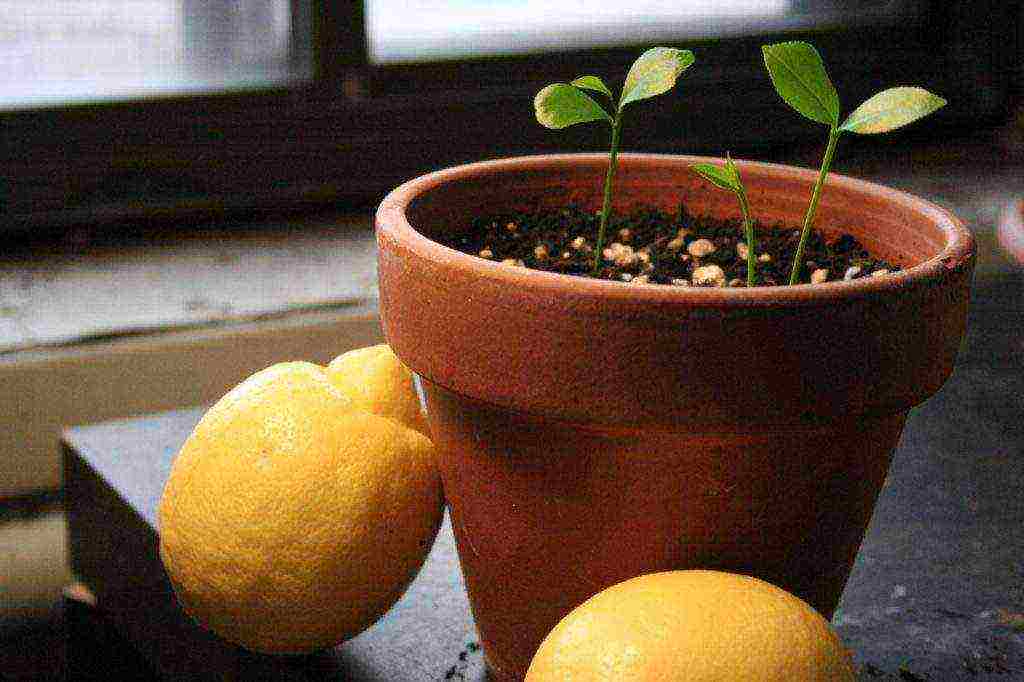
For successful growth and development, lemon needs to be provided with good lighting, warmth and humidity. Avoid direct sunlight, they can burn the leaves. It is not recommended to place the pot in a draft.
Watering is moderate, the ground should be slightly damp. Tropical crops are very fond of spraying, so get a spray shower often.
How to "make" citrus fruit
Of course, I would like not only to admire the decorative bush, but also to see the flowering, and also to taste the fruits.
Not all seed-grown plants will be able to bear fruit. Sometimes you need to wait up to 10 years, and sometimes you can not wait for the fruit at all. In this case, the vaccination from the "giving birth" plant will help. The process is quite complicated and time-consuming, but if all conditions are met, it can give a positive result. Be sure to follow the advice of experienced florists.
To get a guaranteed harvest, purchase an already grafted young tree, so you will avoid the hassle of breeding.
Among the cardinal measures to enforce flowering can be attributed a risky method to put the plant in conditions between life and death. To do this, bring the tree to dryness until the leaves fall, and then create favorable tropical conditions. However, this method is cruel to a living being and can lead to the death of a lemon.
Helpful hints
- Do not buy a plant in a greenhouse, lemon does not like changes and does not adapt well to new conditions.
- When choosing a seedling, carefully examine it. The root system must be sufficiently developed.
- It is best to buy a grafted young bush, it will more easily get used to the atmosphere of your apartment and will definitely bear fruit.
Conclusion
Whatever kind of lemon you grow, take care of it with love, and it will repay you not only with a blooming look, but also with a delicious fragrant harvest.

